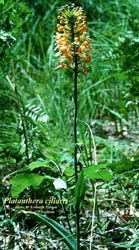Plant Profile: Yellow or Orange Fringed Orchid, Platanthera ciliaris
This post is one of a series from professor Nisse Goldberg's Botany students at Jacksonville University.
Classification
Kingdom: Plantae
Division: Magnoliophyta
Class: Liliopside
Order: Orchidales
Family: Orchidaceae
Genus: Platanthera
Specific epithet: ciliaris
Description
Florida is known for beautiful beaches and theme parks but the “Sunshine State” is also home to the native and endangered Platanthera ciliaris! Of the other 9 native Platanthera species, 5 are listed by the state as endangered or threatened.
 |
| Figure 2. Fringed lip and long, narrow nectar spur of P. ciliaris. Photo credit: Roger Hammer. |
The orange fringed orchid is mainly pollinated by butterflies. They stick their ‘tongue’ or proboscis far down the nectar spur to reach the nectar and at the same time pick up or deposit pollinia, masses of pollen. Butterflies that pollinate this species include Papilio troilus (spicebush swallowtail), Battus Philenor (pipevine swallowtail), Papilio glaucus (white-lined sphinx mouth), and Phoebis sennae (cloudless sulfur).
Orange fringed orchids flower from July-September but are especially abundant during the month of August. Look for them in the central to northern counties in swampy and woodland habitats. You may be lucky enough to find patches along the roadsides!
Resources
- Classification for kingdom plantae down to species platanthera ciliaris (l.) lindl.. (n.d.). Retrieved from http://plants.usda.gov/java/ClassificationServlet?source=profile&symbol=PLCI2&display=31
- Subrahmanyam, P. (n.d.). Orange fringed orchid, yellow fringed orchid (platanthera ciliaris). Retrieved from http://www.flnativeorchids.com/natives_gallery/platanthera_ciliaris.htm
- Platanthera ciliaris (l.) lindley orange or yellow fringed-orchid. (n.d.). Retrieved from http://mnfi.anr.msu.edu/abstracts/botany/Platanthera_ciliaris.pdf
- Robertson, J., & Wyatt, R. (1990). Evidence for pollination ecotype in the yellow-fringed orchid, platanthera ciliaris. Pollinator Conservation Digital Library, 44(1), 121-133. http://libraryportals.org/PCDL/research/157
- http://www.wildflower.org/plants/result.php?id_plant=PLCI2
- Judd, WS, Campbell, SC, Kellogg, EA, Stevens, PF, and Donoghue, ML. 2008. Plant systematics: A phylogenetic approach. Sinauer Associates, Inc. Massachusetts, USA
- Wunderlin, RP and Hansen, BF. 1998. Guide to the Vascular Plants of Florida. Gainesville: University of Florida.
Image Sources




Comments